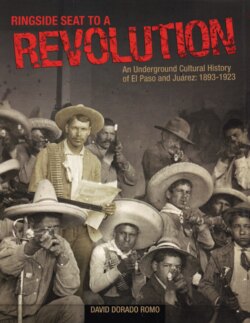Читать книгу Ringside Seat to a Revolution - David Dorado Romo - Страница 28
На сайте Литреса книга снята с продажи.
Оглавление23
having the audacity to wear bloomers during her bike
trip. These women belonged to the Christian
Temperance Union, which had been organized to try
to rid the town of its 25 saloons.
It was difficult for women in turn-of-the-century
El Paso to break out of the strict societal roles
reserved for them. In 1896 El Paso female school
teachers were not allowed to get married, drink,
smoke or be seen in public after 9 p.m. City leaders
designated a five-block zone
south of Utah Street (today’s
Mesa Avenue) as the
“Reservation.” It served to seg-
regate not Indians, but “women
of ill repute.” Alternative sexual
lifestyles for women were, of
course, completely out of the
question. On September 29,
1896—the same month Teresita
would get in trouble with the
authorities for her alleged revo-
lutionary activities—the El Paso
Times reported that “the police
were on the lookout for a
woman who was masquerading
on the streets in men’s clothes.
She was first noticed eating in a
restaurant.”19
TERESITA ALSO DID not
exactly fit current notions of a
woman’s place in society on
either side of the border. A
woman of many contradictions,
she defied all the reigning
stereotypes of a nineteenth-century mujer mexicana.
Newspaper ad announcing El Paso’s first
movie screening at the Myar Opera House.
(El Paso Times,
October 15, 1896.)
She was the illegitimate daughter of a rich
Sonoran hacendado, Don Tomás Urrea. Her mother,
Cayetana Chávez, was a poor Tahueco—part Cahita,
part Tarahumara Indian—woman who had once been
employed as Don Tomás’ maid. Don Tomás impreg-
nated Cayetana when she was 14 years old.
Teresita dedicated her life to healing the poor.
One observer claimed that more than 200,000 people
had visited her home in Rancho Cabora, Sonora; she
had healed 50,000 of them. Most of them couldn’t
afford a physician. Yet she intermingled comfortably
with high society on both sides of the border,
although she had practically no formal schooling.
Later in life, she even won a New York beauty con-
test. According to her half-sister, Anita Treviño Urrea,
that was one of Teresita’s proudest moments.
The masses considered her a saint, yet many
would stop believing her after she married, divorced
and later cohabited with an Anglo man. He was sev-
eral years younger than her. She bore him two daugh-
ters out of wedlock. The Catholic church considered
her a heretic, the Spiritualists considered here too tra-
ditional in her religious
views, and the Mexican
government considered
her a dangerous subversive.
She was opposed to the
spilling of blood, yet the
rallying cry “Viva Santa
Teresa” was heard during
several uprisings through-
out northern Mexico.
According to a Mexican
official quoted by the New
York Times, Teresita was
responsible for the death
of more than 1,000 people
killed during those upris-
ings. At 19, Teresita was
forced into exile by
President Porfirio Díaz.
She crossed the border
into the United States in
1892, the year that the sol-
diers of Porfirio Díaz mas-
sacred and burned down
the entire village of
Tomochic.
FOR MORE THAN two weeks in October 1892,
1,200 federal troops laid siege to Tomóchic, a small
Chihuahuan village about two hundred miles south of
El Paso.20 The trouble began a year before, when the
charismatic leader of the village, Cruz Chávez, kicked
the local priest out of town. Chávez was the leader of
a spiritual movement inspired by the miraculous heal-
ings of Teresita.21 (Reminiscent of the modern day
Pentecostals, Chávez “spoke in tongues” during his
religious services.) The Tomochitecos made pilgrim-
ages to Rancho Cabora to pay homage to the young
woman, be healed by her, and ask for her advice.
Because Teresita believed that God’s healing could
manifest itself without the mediation of the Catholic
19
El Paso Times, September 30, 1896.
20
The most complete accounts of the battle of Tomóchic are Rubén Osorio’s Tomóchic en llamas and Paul Vanderwood’s The Power of God Against
the Guns of Government: Religious Upheaval in Mexico at the Turn of the Nineteenth Century.
21
Cruz Chávez’ son, Cruz Chávez Méndias, would later become a colonel in Pancho Villa’s army.
